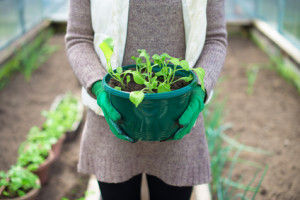It’s hard to believe that spring is just a stone throw away, especially when you look out the window to a snowy white world. Honestly, now is the perfect time to “prepare” your gardens for the “fruits of your labors.”

- Spread manure and/or compost on garden when ground is frozen.
- Apply lime to lawn or garden if necessary (take a soil test in your lawn and/or garden).
- Cut out all dead wood from roses and trim to shape.
And at the end of the month . . .
- Remove straw from strawberries.
- Remove tree guards and wind screens.
- Plant onion sets, peas, lettuce and seed potatoes.
- Fertilize small fruits; raspberries, blackberries, blueberries, strawberries.
When the snow is still flying outside, it is a good time for you to get a jump on spring by sowing vegetable seeds indoors. All you need is potting soil or a germination mix, an egg carton, and good natural or artificial lighting. Don’t forget that once the seeds have sprouted one set of leaves, thin out so that there is only one seedling per cell. Having your own garden allows you the opportunity to grow unusual varieties that you can’t find at a grocery store.
Speaking of the grocery store, how about a few tips to help you feed your family the best quality fruits and vegetables.
Watermelon contains high amounts of the antioxidant lycopene, which gives the fruit its signature color (also found in red tomatoes). Do you know how to pick a perfect watermelon? Just look for a yellow belly. The large yellow spot indicates the fruit is ripe and ready to eat.
Tomatoes come in two classes; fresh to market tomatoes which are perfect for eating raw and processing tomatoes with traits making them better for cooking preparations like sauce or ketchup. When choosing tomatoes at the grocery store or farmers market, pick fruits that are bright red for immediate use and pale pink/orange for future use. Once you get home from the grocery store, never put your tomatoes in the fridge. The chill causes the fruit to undergo a chemical change that weakens the flavor and texture, causing them to ripen faster.
Peppers are perfect for the flu season, especially orange peppers. They have similar amounts of vitamin C as an orange. Refrigerate peppers unwashed in a plastic bag in the vegetable drawer. Red, yellow, and orange peppers will last four to five days; green peppers, about a week.
Sweet Corn is best picked by feel. Feel the cob, check the girth of the cob itself and the tip. A tip that has more girth means that ear of corn had enough time to mature and the sugars in the kernel have developed. Also feel to see how tight the husk is to the cob. When the cob feels tight in the husk, it usually means the water content of the kernels is still high. This indicates that the sweet corn is fresh and was recently harvested.
Cantaloupe is a great source of potassium, in fact, one cup of honeydew provides nearly the same amount of potassium as an average-size banana, but has half the number of calories. When selecting a cantaloupe in the summer months, look for a golden-colored melon with a clean, round hole where the stem once was and you can be sure it will be sweet and delicious.
Fruit and vegetable facts courtesy of Farm to Plate, Learning How Food Is Grown by Monsanto Company